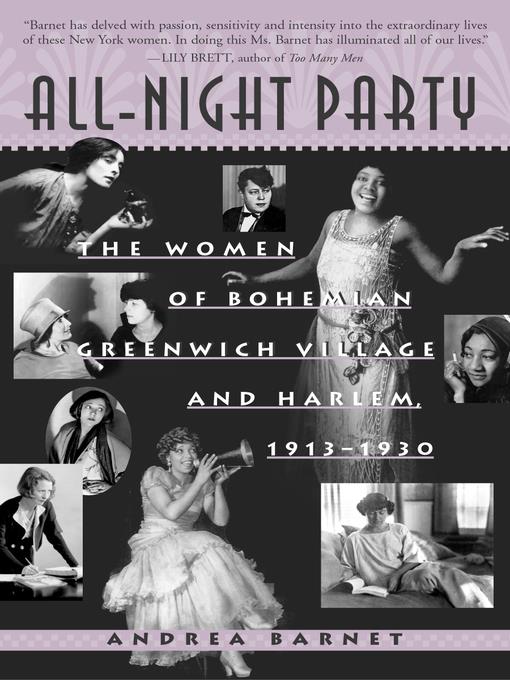
All-Night Party
The Women of Bohemian Greenwich Village and Harlem, 1913-1930
کتاب های مرتبط
- اطلاعات
- نقد و بررسی
- دیدگاه کاربران
نقد و بررسی

December 22, 2003
With a neatly composed set of intersecting biographies, journalist Barnet engagingly illustrates the extraordinary period of cultural freedom for American women that came after whalebone corsets of the Victorian era were loosed and before the privations of the Depression sucked the gumption out of the nation. Barnet uses New York as the red-hot locus where these women met, mingled, made love and made art. At the book's heart are eight creators. In Greenwich Village, modernist poet and artist Mina Loy wrote her manifesto "Aphorisms on Futurism." Nearby, the winsome Edna St. Vincent Millay burned her candle at both ends in a cold-water flat, breaking cultural rules and several suitors' hearts. Editors and lovers Margaret Anderson and Jane Heap constructed the influential arts magazine Little Review
, which climaxed with the serial publication of Joyce's Ulysses
. Uptown, in Harlem, blues divas like the wild Bessie Smith and coy Ethel Waters crooned to audiences of blacks and whites alike. A'Lelia Walker, the richest black woman in America, hosted a salon where, "besides the usual throng of artists, dancers, jazz musicians, poets, journalists, critics, and novelists, one might see English Rothschilds, French princesses, Russian grand dukes, mobsters, prizefighters, men of the stock exchange and Manhattan's social elite, elegant homosexuals, Village bohemians, white movie celebrities, and smartly dressed employees of the U.S. Post Office." Barnet's treatment of this scintillating era is as lively and appealing as the women she's writing about. B&w photos. (Mar. 26)
Forecast:
March is National Women's History Month, and national publicity and promos around that time, coupled with national advertising, could help this book find a market.

March 15, 2004
Take a period of profound social change, add an atmosphere of intellectual and cultural ferment, and mix with women of creativity and courage. The result? Greenwich Village and Harlem from World War I to the Great Depression, brought to life by art and culture writer Barnet. Following a scene-setting prolog, she plunges readers into two distinct urban milieus, each with its own aura and characters. And oh, what characters! Poet Edna St. Vincent Millay, entertainers Bessie Smith and Ethel Waters, hostesses Mabel Dodge and A'lelia Walker, and editors Margaret Anderson and Jane Heap share the stage with the likes of renaissance figures Mina Loy and Baroness Elsa von Freytag-Loringhoven, who simply defied categorization. Throughout, Barnet displays a gift for re-creating these flawed but fascinating individuals. An epilog makes a good case for the continuing relevance of these women and their stories; Barnet is to be especially commended for giving equal voice to the women of Harlem who, as a group, have been too long neglected. The informal style, supported by obviously serious scholarship, makes this work suitable for both public and academic libraries.-M.C. Duhig, Carnegie Lib. of Pittsburgh
Copyright 2004 Library Journal, LLC Used with permission.

March 1, 2004
The span between 1913 and 1930 was a time of scandal-laced creativity for New York City's fierce Bohemian spirits, who tended to congregate in two centers: Greenwich Village and Harlem. Barnet focuses on that era's bold feminists, including Mina Loy, a beautiful modernist poet, and Margaret Anderson and her lover, Jane Heap, founders of the famed " Little Review" . These blazing talents crossed paths with other creative women, such as the sexually daring poet Edna St. Vincent Millay; social activists Emma Goldman and Margaret Sanger; the revolutionary dancer Isadora Duncan; and blues divas Ethel Waters and Bessie Smith. They met at (in)famous salons like Mabel Dodge's, and their creative cross-pollinations were to shape an age, attitude, and a feminist movement for decades to come. Barnet's beautifully detailed portraits of these pioneering women are delicately shaded, filled with resonating emotional nuance, and surrounded by such stellar supporting characters as Carl Van Vechten, Edmund Wilson, and Djuna Barnes. Boasting Man Ray photos and Beatrice Wood drawings, copious end notes and bibliography, " All Night Party" is sure to arouse great interest. (Reprinted with permission of Booklist, copyright 2004, American Library Association.)

























دیدگاه کاربران